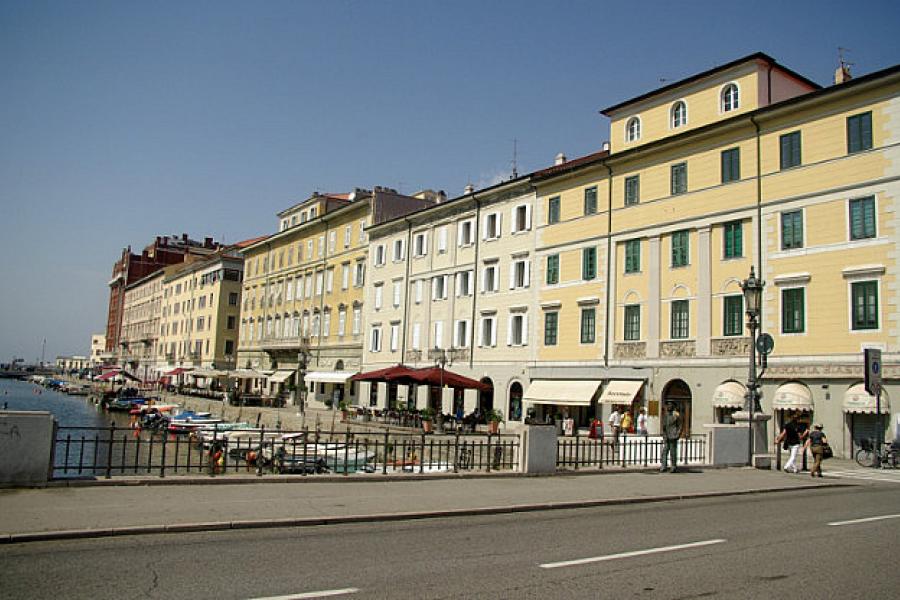3. Searching for Andreas Hofer
Country
We made an early start on our ride down to Trieste to try and avoid the worst of the heat. It was another hot day and by the time we had settled into a large room in what was once a palatial villa we were melting in our riding suits. Trieste is situated at the top of the Adriatic. It developed during the 18th and 19th centuries as a thriving port for the Austro-Hungarian Empire serving the hinterland that is now Slovenia, Croatia and Austria. At the end of WWI the city was ceded to the Italians as reward for having joined hostilities and starting a southern front against the Germans and Austrians. The change of management deprived Trieste of its purpose and of much further development.
These days Trieste remains in its pleasant, unhurried, decaying 19th century splendour without a driving commercial purpose and no real prospects for the future. When the Fascists came to power in the chaos after Italy's military calamities of WWI, they saw Trieste, and the other recently ceded territories, as a focus for a campaign of nation building. This led to the usual round of streets being named after heroes of the Risorgimento (the Italian unification) and the erection of grotesque monuments to the WWI martyrs. The awful example on this page is typical in its depiction of heroic Italian soldiers raising the flag in the newly liberated territory. This was, of course, a complete fabrication. The war was over when the Italians came to Trieste.
The most interesting comparison, however, was between the depiction of the overdeveloped specimens of manhood raising the flag and the thousands of photos of the real soldiers who fought and died in that war we had seen in the museum at Kobarid. The Kobarid photos were of stunning quality but they were of ordinary men who looked a little underfed and weedy; just blokes like you would find on the streets of Vienna or Milan, some with pot bellies and skinny arms. There was not an over-muscled physique among them. But it was the ordinary blokes who fought the bitter alpine war. It was the ordinary blokes who fought on with the Alpini when their own headquarters decamped behind them; fought on when hope was gone; fought on until their names filled the walls of a dozen churches and their mothers had cried a river of tears.The little statue down on the harbour of two handsome and very patriotic ladies sewing the Italian flag was a little more to our liking. After all, the girls were probably paid for their work.
We also discovered that Trieste had a museum of the Risorgimento. We couldn't figure out why, as the Risorgimento had happened in the south of the Italian peninsula so we went to investigate. We found the place locked up and looking derelict. It was open only two mornings a week for a few hours. We took some photos, ate some excellent Italian icecream and packed to head north again and back to the Alps.
Our route was about as convoluted as we could manage as we tried to cross every quality motorcycle road we had heard about. In Austria, south of Salzburg, we crossed the famous Grossglockner. We rode this way in 2011 and had enjoyed the journey very much despite the 18 Euro fee to use the road. At the time I thought it was the best 18 Euro I had ever spent. We have a great photo from that trip with me standing under the sign showing the altitude and rugged up in all my gear with a wool beanie pulled down and the mist swirling around. This year was a bit different. The price had gone up to 22 Euro, the weather was hot, even over 2000 metres, and every tourist in southern Europe had decided to turn the road into a traffic jam. Still, we've ridden Grossglockner twice and that can't be a bad thing.
We pressed further west through Austria crossing Alpine passes another half dozen times on our way to Innsbruck and our date with Andreas Hofer. Long-term blog readers will remember Andreas from a stop last year at a little village in Sud Tirol called St Leonhard which was, as it turned out, the birth place of the inn keeper, wine merchant and insurrectionist, Hofer. We decided to visit the “capital” of the Tyrol and the burial place of the greatest hero of Tyrolean nationalism.
Hofer won a significant battle on a hill outside Innsbruck and the victory is recorded in a giant late 19th century painting housed in a museum near the site of the battle. I have included a photo of a part of the painting to show the reason the Tyroleans won on the day. They had the best hats! The huge brimmed Tyrolean hats are fantastic and anyone who could fight in one deserves to win!
Hofer is buried in a church which also contains the tomb of Emperor Maximilian I. This is an extravagant monument surrounded by life-size bronzes of the kings and queens of European antiquity. The one shown close up in the photo is of King Arthur of England and the observant English reader will note the dragons on the armour to prove it. Hofer's grave is nearby and is a far less grand affair. He was, after all, just a local freedom fighter who was eventually defeated militarily, then betrayed and executed as revolutionaries often are. The laugh, however, is that Hofer is actually buried in the church. Maximilian is not. It seems that the Emperor's entourage was refused entry by the city burghers because his soldiers hadn't paid their bills. He is buried near Vienna. This small fact was missing from the fancy sound and light show presented to the thousands of tourists who flock to see Maximilian's mausoleum each year.

























